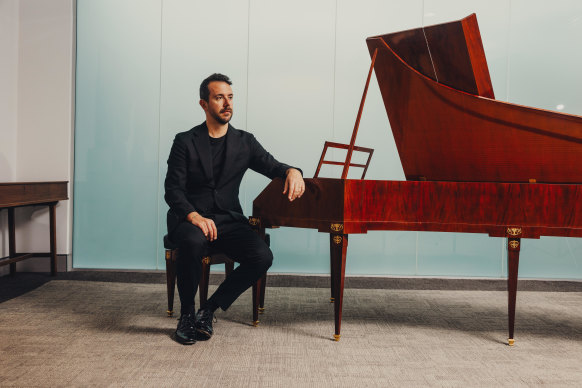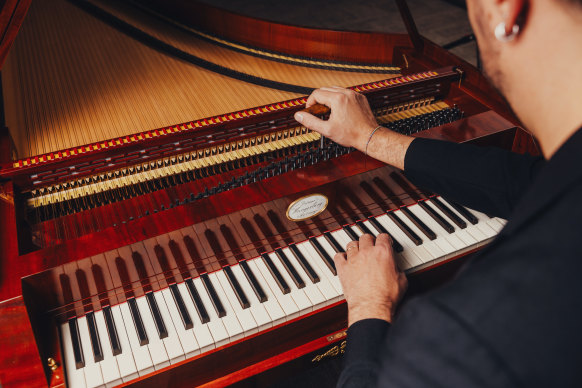This was published 9 months ago
Without a time machine, this is the closest you’ll get to hearing Mozart play
Francesco Corti is one of the few people to have played Mozart’s own fortepiano. One of the world’s leading harpsichordists, Corti is also a virtuoso organist and pianist, a conductor, musical director of the Royal Swedish Opera at Drottningholm, academic and teacher at Basel’s Schola Cantorum in Switzerland.
In a series of Australian concerts with the Australian Brandenburg Orchestra, the musical polymath will play Mozart’s magnificent 23rd piano concerto. The concert at the Melbourne Recital Centre will also includes Mozart’s final symphony, Jupiter.

Francesco Corti will perform on a replica of Mozart’s fortepiano in a series of concerts in Melbourne and Sydney.Credit: Dion Georgopoulos
When we talk, Corti has just arrived in Australia and has played “literally just five notes” on the fortepiano he will use, a replica of Mozart’s commissioned for the the Brandenburg Orchestra. But he can already tell that it is a beautiful, full-sounding instrument, very similar to Mozart’s own, which he knows having played it at a concert in Salzburg, Austria.
That experience was very emotional, Corti says, but then the practicality of the concert kicked in. “It’s very stressful. Salzburg is an educated public, they know their Mozart very well, so you concentrate on playing as well as you can.”
What was touching, he said, was that Mozart used the keys in the middle of the keyboard so much, that “the central B flat and F sharp are actually consumed. You have this also in historical organs – the surface has almost a hole – and it’s a very tender feeling, a very private thing, very nice.”
Corti, 40, a specialist in historical instruments, says their advantage over modern pianos is their directness, intimacy and agility, while they also change the sound blend with the baroque orchestra, allowing each instrument to bring a distinct colour.

A modern piano demands the whole arm and sometimes the shoulder as well as the fingers, whereas with a fortepiano one uses only the fingertips.Credit: Dion Georgopoulos
“It brings a certain direct expression to the music, which tends to speak more freely in [historical] instruments. Some intentions of the composers which are in the notation are much easier to translate into music than if you play a modern instrument.
“On a fortepiano like the one I have, the action is so much more agile than a modern piano that you can do more articulation and accents and the little details in the phrasing that wouldn’t be possible on a modern piano.”
Historical instruments more easily imitate the articulation of wind instruments, strings or the sung voice, he says. Modern pianos can play twice as loud because they are built for huge halls, whereas 18th-century halls are more “human-focused” – one can speak and be heard, and the idea is that music should speak the same way.
Even the action of playing is different. A modern piano demands the whole arm and sometimes the shoulder as well as the fingers, whereas with a fortepiano one uses only the fingertips – more than that risks the sound becoming ugly.
Corti concedes that it is challenging to move between harpsichord, organ and piano with their very different actions. “I need a bit of time when I switch from one instrument to another, also when I switch from one pitch to another, but this is part of the job.”
The harpsichord sounds by a plectrum plucking a string, a fortepiano by a hammer hitting double or triple strings, an organ by opening a valve, and a clavichord by a metal tongue hitting a string. “I normally spend a couple of days playing on an instrument until my body gets used to it and I don’t have to think about what I am doing any more.”
Corti’s advice to the audience is to focus on the beauty and refinement of the works. Mozart, he says, brings a unique blend of ingenuity, directness, humanity and spirit. “It is very touching and cultivated music, but under the youth and freshness of the surface there is a lot of complexity – and, really, historical instruments make the journey for the listener much easier.”
Francesco Corti will perform Mozart’s Jupiter with the Australian Brandenburg Orchestra at Melbourne Recital Centre from October 24 to 27 and City Recital Hall, Sydney, from October 29 to November 2.
The Booklist is a weekly newsletter for book lovers from Jason Steger. Get it delivered every Friday